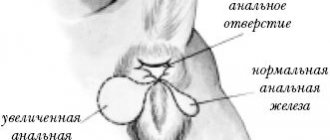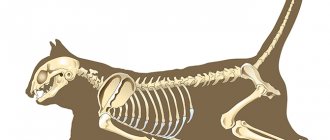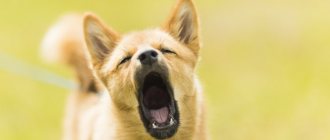A dog's tail is a kind of appendage that is an extension of the spine. It is equipped with nerve endings, blood vessels and muscles, and, therefore, is a full-fledged part of its body and plays an important role in the life of the animal.
In addition to its main functions, such as maintaining balance during movement, the ability to make sharp turns of the body, maintaining optimal body position in the water, it has another role: the dog’s tail is an indispensable means of communication. Its different positions and amplitude of movements can express the animal’s mood in each specific situation and speak about its further actions. From this article you will learn why a dog wags its tail, and what its particular position relative to the body means.
Why do dogs wag their tail? - the expert answers.
It seems that everyone knows that a dog, wagging its tail, talks to its owner in this way. A dog's tail is not just a balancer for maintaining balance and comfortable movement when running, but also an excellent tool for communication.
Tail wagging is considered a social signal among quadrupeds. It can be a vigorous movement or a slight waving of the tip of the tail, it can be expressed in circular movements or holding the tail at different heights: as high as possible, at the level of the back or between the hind legs.
What does all this mean? After all, if you look closely at the behavior of our pets, canis familiaris, you will notice interesting nuances - for example, dogs wag their tail even in situations that are considered, by dog standards, unpleasant and dangerous: strangers, postmen, an annoying neighbor's cat, and so on.
Even if a dog is barking or growling, it may wag its tail in a similar way to when it is happy to see someone. That is, the gesture clearly does not imply happiness, as many dog owners misinterpret a change in mood. Maybe there is some clue or subtle nuance to the behavior of dogs during wagging? Let's find out!
To do this, let's turn to veterinarians, in particular to a specialist who specializes in behaviorism (studies the behavior of animals and people).
Is it difficult for dogs with short tails to express their mood?
Studies by behaviorists have proven that when communicating with each other, four-legged pets pay special attention to the length of the appendage of their opponents. The shorter it is, the more difficult it is to understand emotions. Because of this, short-tailed breeds are more likely than others to be attacked aggressively. The same applies to docked dogs.
If a short-tailed dog wags its tail in a friendly manner, other animals still try to avoid it. For this reason, in addition to wagging, she tries to use other means of communication: her voice, ears, eyes and body position.
IMPORTANT!
The hardest thing is for puppies. Children often run into the indignation of short-tailed adults, perceiving their refusal to play as an invitation. For this reason, during a walk, it is better to check with his owner about the mood of someone else’s dog.
Why do dogs wag their tail?
It turns out that tail wagging coincides with a whole range of four-legged emotions, not just happiness and excitement. According to Lynn Buzhardt, DVM, veterinary consultant for VCA Animal Hospitals, dogs will often wag their tail if they sense:
- threat;
- anxiety;
- uncertainty;
- interest;
- curiosity or friendliness.
Determining your dog's exact emotion depends on three factors:
- positions of the whole body when wagging the tail;
- wobble speed;
- and, most importantly, context.
Breed and tail position
The constant position of a dog's tail often depends not on his mood, but on his breed. You need to be aware of this, since a natural breed trait can be mistaken for the expression of one or another emotion.
Here are some of the most common provisions:
- among representatives of hunting breeds (in particular, greyhounds) the natural position is down;
- in Italian Greyhounds it is constantly lowered and tucked towards the hind legs;
- in pugs, it is funny curved upward and lies on the back;
- in Labradors - located just below body level;
- in huskies it forms a fluffy ring.
For many breeds, the tail is an integral decoration, without which their image would be incomplete. The length of this appendage is defined in the standard of each breed, which is a criterion for thoroughbredness.
What does the wobbling pose tell us?
photo: flickr.com / Aaron Sorrell
A 2013 study of canine body language by the Department of Veterinary Medicine at the University of Bari, Italy, confirms that the position of a dog's tail wagging, corresponding to the location of the left and right hemispheres of the brain, determines the types of emotions they experience.
A strong right wag (when your dog's tail wags more to the right than to the left) reflects positive emotions , while a strong left wag (when your dog's tail wags more to the left than to the right) reflects negative emotions .
A tail in the up position establishes dominance and assertion , while a tail in the down position shows a submissive attitude .
Why do pets scratch their bed before lying down?
You have probably noticed more than once that, before lying down, your dog spins in one place and scratches the bed with its paws.
For our little brothers this is a very important rite, as their ancestors prepared a place to sleep. This helped them not only to crush the grass or remove the top layer of earth, but also to scare away snakes, spiders, and other dangerous creatures hiding in it. Unlike dogs, cats knead not only their sleeping place, but also any surface (even your lap) before lying down on it. They have kept this habit since childhood. The fact is that kittens massage their mother's belly to stimulate milk production. In addition, sweat glands are located on the pads of a cat's paws, thus, by massaging the surface, cats simultaneously mark the territory with their scent.
What does a dog “tell” us when it wags its tail?
Tail wagging is also a social indicator, which means: a dog will not wag its tail unless it is around other dogs or people . Even though "tail talk," as Dr. Buzhardt calls it, is a form of communication, dogs don't talk to themselves, so you won't see your furry friend wagging his tail if he's alone in the house.
“Puppies, when they are born, don’t know what it means to wag their tail any more than a newborn baby understands words,” explains the veterinarian. They usually start wagging their tail at 1 month, and since they are born in a litter, they learn how to do this from each other. Puppies learn that they can use their tail movements to communicate with their mother if they are hungry, or with their siblings if they want to play or are not socially inclined.
Aggression and anger
If the dog is aggressive (the result of poor upbringing or its complete absence), then attacks of aggression are observed when meeting another dog. The dog begins to tear, the tail behaves very actively - the dog can whip itself with its tail, twist it. Exhortations are useless. You need to sharply pull the dog towards you and give the command in a voice: “Near”, “Stand”.
Even if the dog waves its tail very complacently, it should be taken into account that for the dog the situation is changing, but the person is not aware of it. The outstretched hand of a stranger, for example, sharply changes the mood of a guard dog in the direction of protection, and an attack ensues.
Wariness and suspicion
The tail is extended almost parallel to the ground and trembles slightly, the withers are calm - the dog is waiting, it can start the game and is ready to defend itself, depending on the behavior of the other party.
If the tail is raised and tense, the hair on the withers rises like the crest of a dinosaur, then the dog senses danger and is preparing to attack. Many dogs, especially service breeds, are of the opinion that the best defense is an attack. The situation can develop in different ways: a tug on the leash will provoke aggression, but a calm admonition from the owner, on the contrary, will resolve the matter peacefully. At such moments, it is useful to distract the dog with the command “Sit” and “Next”.
The raised tail is characteristic of alpha males. Such dogs are confident in themselves and prefer to find out the situation until the end. Serious fights are very rare, if they even happen. One dog will put the other down, stand over him, holding his head above the withers, and move away. It is not uncommon for confidence to allow a smaller, physically weaker dog to dominate others. And the intelligence of such dogs is above average.
Fear and Submission
If the tail is in a position between the paws - tucked, then the dog experiences discomfort, more often it is fear, but it happens that the dog simply has nowhere to go and avoid unpleasant communication with someone. This could be a pestering dog, an annoying child (children love to grab a dog's tail, which is understandable, but dogs really don't like it) or, unfortunately, a veterinarian.
The submission position in front of a dominant dog is also characterized by a tail tucked, the rear bent to the ground and the dog demonstrates its submission by opening its neck (by moving or lowering its head).
Why do cats purr?
Most zoologists agree that cats purr because they have special bones under their tongues.
First, the animal's vocal cords begin to vibrate, which causes the hyoid bones to vibrate, resulting in a strange sound. At the same time, our fur “tractor” does not have to make any special efforts to purr. Everything happens at the level of reflexes.
Another question is why does a cat make such a sound? What motivates her to do this? A cat can purr for various reasons; if it does this when communicating with a person, it is most likely an expression of joy and calmness from being next to you. Purring is also a means of communication between cats or a mother cat and her kittens.
According to scientists, animals also use purring for medicinal purposes. There are a number of studies according to which the frequencies emitted when a cat purrs promote wound healing, improved health and faster treatment of illness.
What does a cat wagging its tail want to tell us?
An animal's mood changes many times during the day, just like any person. To determine a cat’s mood by its tail, just watch it:
Photo: Cat | Dreamstime.com
- The cat’s tail is directed upward, the hair on it stands on end, the back is arched, the eyes are widened - the animal is in a state of extreme anger (perhaps there is an object of the pet’s hostility nearby: a strange cat, dog);
- Standing or sitting, the cat swings its tail chaotically, hitting the floor or its own sides with force - the pet is extremely unfriendly and is even capable of launching an attack. This “behavior” of the tail can be observed, for example, after a cat meets an opponent or after games that are unpleasant for the animal (throwing the pet up to the ceiling, actively stroking the belly, etc.);
- The cat shakes its tail quickly and shallowly, pointing it upward - a sign of excitement, including sexual excitement. This behavior can be noticed in a cat when it sees an individual of the opposite sex or is in anticipation of its favorite treat;
- The cat presses itself to the ground or floor, lowering its tail, the tip of which twitches finely and nervously - a signal that the hunting instinct has awakened in the pet (there is a rodent, bird, insect nearby);
- The cat wags its tail not too actively - a sign that the purr is considering its actions, for example, deciding whether to have a snack now or go for a walk;
- The pet has its tail pointed upward, perpendicular to its back - a good sign that means the animal is in good position. With their tails up and purring, friendly cats greet their owner returning from work;
- While sitting, the pet actively wags the tip of its tail, looking interestedly at one point - a sign that the animal is currently in a playful mood. This behavior of a cat can be seen while tracking a toy mouse on a string;
- The cat sits, looking into the eyes of the owner, and its tail wags along the floor at medium speed - the animal’s attempt to attract attention (“master, look at me”);
- The tail is fluffed and lowered down, the paws are slightly tucked - this means that the pet is scared (for example, by a vacuum cleaner suddenly turned on or by an unknown person coming into the house);
- The cat sits, stands or lies, and its tail is in a calm state - a sign of peace and good mood;
- The cat waves its tail, raising it horizontally - an action that means that the animal is wary and mistrustful. This happens if a family friend has not finally decided that he is safe (for example, if he came to someone else’s yard or ended up in a veterinary clinic);
- The pet's tail is directed vertically, and the tip is slightly bent - a good sign indicating that the animal is in a calm mood;
- The cat went to a place of rest and even dozed off, but its tail, nevertheless, slowly moves from side to side - a signal that the animal is worried about something, is nervous and does not feel safe. Such a sight can be observed, for example, if the animal is irritated due to loud noises in the room or on the street;
- The pet's head in a standing position is lowered down, the tail hangs indifferently and relaxed between the paws - the pet Murzik makes it clear that he is sad or bored;
- The pet almost falls on the owner’s legs, wrapping his tail around them - a clear sign of flattery. So an animal can beg for food or call for affection;
- A cat with its tail raised up and slightly bent at the tip approaches the owner and lightly bites his leg - an attempt to attract attention (“master, don’t forget to play with me” or “feed me)”;
- A domestic friend pokes his head at his owner, raising his tail vertically - a sign of love and friendship. Usually cats behave this way only with the people they like the most and never with strangers.
Calm and interested
The tail hangs calmly in the middle - the dog is calm, it is self-confident and is simply waiting for events to develop. Dogs are very impatient and very soon the tail begins to wag slightly and the dog looks at the owner, waiting for his order. If the order is not given, then she will try to change position - sit or lie down.
Also, weak wagging of the lowered tail occurs when the dog does not understand the situation, but does not feel anxiety. In the presence of the owner, the dog is calm, but uncertainty confuses him, and the dog may begin to yawn.
When they see an unfamiliar object, dogs become wary, they are interested and a little scared. This usually occurs in puppies or adolescents. They do not have a well-established pattern of behavior and rely on instinct. The tail is lowered or slightly raised, depending on the dog's confidence, and quivers. The owner should lead the dog to such an object (it could be a balloon or a newspaper in the bushes), calmly convincing the pet that everything is in order and there is nothing to be afraid of.
Why do cats drop things?
The cat jumps on the chest of drawers and throws off the lipstick with its paw, then, as if accidentally, touches the cream with its tail, etc. A familiar situation, isn’t it?
Is it worth scolding a pet for such behavior or is this another instinct inherited from its ancestors? In reality, cats are very graceful animals, and if they knock something over, it is most likely on purpose. However, this behavior does not necessarily mean that your pet is simply acting up (although this is possible), it is likely that he is simply trying to get your attention or is very nervous.
Functions of the tail
- The tail is responsible for transmitting nerve impulses, maintaining normal cerebrospinal fluid pressure and regulating muscle balance.
- To maintain balance when moving. This is especially noticeable when the dog runs and overcomes obstacles. Dogs “steer” with their tail. When a dog swims, the tail helps maintain optimal body position in the water.
- The tail is an indicator of the dog's mood. Dogs are very emotional, their mood changes as the situation changes, and the situation changes constantly, although people usually do not notice this.











